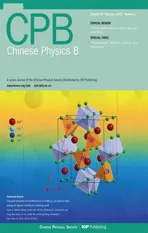Unusual tunability of multiferroicity in GdMn2O5 by electric field poling far above multiferroic ordering point∗
2019-02-25XiangLi李翔ShuhanZheng郑书翰LimanTian田礼漫RuiShi石锐MeifengLiu刘美风YunlongXie谢云龙LunYang杨伦NianZhao赵念LinLin林林ZhiboYan颜志波XiuzhangWang王秀章andJunmingLiu刘俊明
Xiang Li(李翔),Shuhan Zheng(郑书翰),Liman Tian(田礼漫),Rui Shi(石锐),Meifeng Liu(刘美风),Yunlong Xie(谢云龙),Lun Yang(杨伦),Nian Zhao(赵念),Lin Lin(林林),Zhibo Yan(颜志波),Xiuzhang Wang(王秀章),and Junming Liu(刘俊明),,3
1 Institute for Advanced Materials,Hubei Normal University,Huangshi 435002,China
2 Laboratory of Solid State Microstructures and Innovative Center of Advanced Microstructures,Nanjing University,Nanjing 210093,China
3 Institute for Advanced Materials,South China Normal University,Guangzhou 510006,China
Keywords:multiferroicity,GdMn2O5,high-T polarized state,exchange striction
1.Introduction
The so-called type-II multiferroics,referring to the magnetically induced ferroelectricity,have enriched the connotation of condensed matter physics and materials science.[1,2]In these multiferroics,an electric polarization(P)emerges as a function of temperature(T)below the so-called multiferroic ordering temperature(Tmo),and is associated with a particular magnetic order and correlated with spin-orbital coupling or spin-phonon coupling.[3-6]In addition to interest from the point of view of fundamental research,these systems exhibit significant coupling between ferroelectricity and magnetism,offering potential for the magnetic control of ferroelectricity or electric control of magnetism.[7-9]Nevertheless,most of type-II multiferroics have low Tmo,relatively small P,and weak ferromagnetism.On the one hand,substantial efforts have been devoted to searching for additional multiferroics such as CaMn7O12and CaBaCo4O7,which show giant improper ferroelectricity and gigantic magnetically induced polarization,respectively.[10-14]On the other hand,the underlying mechanisms and emergent phenomena in already available multiferroics have been investigated persistently.[15-17]Along this line,we discuss one class of type-II multiferroics,rareearth manganite R Mn2O5that has been considered due to its intriguing multiferroic mechanism and compelling physical properties.[18-20]It is our motivation that these unveiled mechanisms,if any,would be beneficial to our designing and synthesizing the novel materials with superior multiferroic properties.
The R Mn2O5family,where R represents Y or rare earth ion,have complicated the physics of multiferroicity with large electric polarizations.It is noted that almost all members of the R Mn2O5family have similar structures[21,22]as shown in Fig.1(a),where GdMn2O5is taken as an example.The Mn4+and Mn3+ions have different occupations with complicated symmetric and asymmetric exchange strictions and thus a strong spin frustration becomes inevitable.[23]With T decreasing,R Mn2O5undergoes a magnetic transition from paramagnetism to incommensurate antiferromagnetic ordering at TN1,followed by the transition to commensurate antiferromagnetic ordering at TN2where a ferroelectric transition is identified.[24,25]This consistency indicates that the observed ferroelectricity in R Mn2O5is magnetically induced,and thus we have Tmo∼TN2.Here,an often misleading consequence associated with the intensive studies is that R Mn2O5should be paraelectric above TN2.
The similarity in magnetic structure of R Mn2O5would imply the similarity of electric polarization in response to these magnetic ordering sequences in the low-T range.However,measured data from several systems[26-29]or even from the same system but different samples synthesized by different authors did show big scattering[18,30-32]as shown in Fig.S1 of Supplementary Material.This issue can be discussed more extensively from various aspects.First,when the general pyroelectric method is used,the measured pyroelectric current I(T)and deduced polarization P(T)as a function of T in the low-T range(<50 K)are qualitatively different for different materials.In quite a few cases,different groups presented inconsistent data from the same system,which is quite unusual.Second,a two-polarization-component model in the low-T range is used to explain the observed phenomena in a recent topical review on ferroelectricity of R Mn2O5.[33]In this model,the two components originating respectively from the symmetric R3+-Mn4+-R3+and Mn3+-Mn4+-Mn3+exchange strictions are available and they exhibit different T-dependence,contributing to the complicated overall I(T)and P(T)behaviors.This model does work well on DyMn2O5and TmMn2O5by describing the ferrielectric lattice but cannot be applied to other systems.[28,34,35]A major uncertainty is that the two polarization components may not necessarily be coupled with each other.Third,the mechanism for the magnetoelectric coupling is still not well understood yet,and inconsistent data about the change of magnetically induced polarization were reported from various groups in GdMn2O5.[30,31]
In addition,our preliminary measurements on DyMn2O5,GdMn2O5,YMn2O5,and TmMn2O5revealed that the measured I(T)and P(T)data depend greatly on the detail of electrical poling of the samples in the high-T range(≫TN1).[28,35]The dependence brought us major difficulty in obtaining interconsistent data of the low-T multiferroicity.We may intentionally correlate the different electric poling sequences in the high-T range with different polarized states.For example,one defines a starting temperature Tst(≫TN1),at which a sample is assigned to the electric poling until an ending temperature(Tend∼2 K in the lowest limit of the present experimental environment).In our experiments,the same sample may show qualitatively different data of I(T)and P(T)if Tstis different.This effect has rarely been observed before and the results imply that the low-T multiferroicity can be controlled by assigning different polarized states in the high-T range.
In fact,it was reported in 2015 that the lattice structure of R Mn2O5family at ambient temperature may belong to the non-centrosymmetric Pm space group rather than the centrosymmetric Pbam.[36]This work has caught attention in the past three years,[35,37-45]and some doubtable ferroelectric loops in the high-T range were measured.[46,47]While this dispute has not been settled,the possibility of polar lattice structure in the high-T range may allow an opportunity to correlate the data scattering of the low-T multiferroicity with the high-T polarized state induced by electric poling or other stimuli.Here,it might be delicate to claim the high-T state as a“polarized state”since the polar Pm lattice structure is questionable and the physical mechanism is pendent.In this paper,the terminology of “polarized state”refers to an electrically poled state in a narrow sense,though nearly no ferroelectricity in the high-T range for most of R Mn2O5members has not yet been confirmed mainly due to the leaky problem.If this is true,the measured I(T)data below TN1by using the pyroelectric method could depend on the magnetically induced component and high-T polarized state.Possible contributions from local lattice/nuclear or other degrees of freedom might be frozen at low T and the memory of the specific high-T configuration is kept.These issues thus arouse substantial interest in investigating the low-T multiferroicity of R Mn2O5for different high-T poling sequences.
Since the specific constraints producing the low-T configuration are not exactly known,tackling the electrical degree of freedom over T in spite of other degrees of freedom at fixed T could be of great help.In this work,we intend to deal with this issue and take GdMn2O5as our object.The GdMn2O5was reported to have the largest polarization in the absence of magnetic field,and a magnetic field of 2.0 T can flip the low-T polarization,inducing a big change(ΔP=5000 µC/m2).[30]However,no such flip by a magnetic field up toµ0H=9 T was observed in another report,making the underlying physics puzzling.[31]In addition,the low-T magnetic ordering of this system with only two magnetic transitions at TN1and TN2associated with the Mn spin ordering has been identified.The Gd spin is roughly isotropic and its independent ordering occurs only at very low T(at TGd).This implies that the Gd spin may be aligned with the neighboring Mn spin but it can be easily re-aligned by an external field(such as a weak magnetic field).[48]Moreover,it is found that the magnetoelectric effect at T≪TN2is remarkable,while the polarization around TN2is almost insensitive to magnetic field.[31,49]As a result,GdMn2O5seems to be an example to explore the possible correlation between the low-T multiferroicity and the high-T polarized state.Polycrystalline samples are chosen for some reasons,which will be discussed in Supplementary Material.
2.Experimental details
The single-phase polycrystalline GdMn2O5was prepared by the conventional solid-state reaction method.The highly purified powder of Gd2O3and Mn2O3were mixed in stoichiometric ratio,ground,and then fired at 1200°C for 24 h in a flowing oxygen atmosphere.The resulting powder was fully re-ground and pelletized under 70 MPa pressure into disks of 2 cm in diameter,and then the pellets were sintered at 1400°C for24 h in a flowing oxygen sphere priorto cooling down naturally to room temperature.The sample crystallinity and structure were checked by x-ray diffraction(XRD)with CuKα radiation at room temperature.The re finement of XRD data was performed by using the standard Rietveld method.The chemical composition and its spatial homogeneity on a nanoscale were probed using scanning electron microscopy(SEM,Hitachi S-4800)to ascertain the microstructure.
For the electrical measurements,Au electrodes were deposited on either side of each of the disk-like samples of 3.0 mm in diameter and 0.2 mm in thickness.The electric polarization P as a function of T in the low-T range(<TN1)was evaluated from the pyroelectric current I(T)data.It should be noted that this polarization is relatively small so that conventional method such as positive-up negative-down method cannot give sufficiently reliable results.
In order to investigate the in fluence of the high-T polarized state on the low-T multiferroic behavior,we designed a set of specific experiments,which will be described in detail in Section 3.For the common pyroelectric measurements,an electric poling was applied to each sample by an electric source with a compliance current of∼0.1 mA.The applied voltage was 200 V for the sample of 0.02 cm in thickness,corresponding to a poling field of 10 kV/cm.Hereafter,the poling electric field is denoted as Ep.By this scheme,the sample was cooled down from a given temperature Tst(to room temperature)to an final temperature Tend(down to 2 K).Then the sample was electrically short-circuited for sufficient time(in our work,the short-circuit time was set to be about 60 min to reduce the background current)at Tend,followed by a slow heating up to a temperature higher than TN1,during which the electric current released from the capacitor was recorded by using the Keithley 6514 A electrometer.The heating rate vtmay be varied from 2.0 K/min to 6.0 K/min in different measuring cycles.The polarization P was then calculated by integrating the pyroelectric current I(T).
Here it should be mentioned that the collection of I(T)data was terminated at T=60 K,and no more data above this temperature would be provided.For all the cases,the current between TN1and T=60 K was zero within the measuring uncertainties.Therefore,the evaluated P(T)here only contained the magnetism-induced polarization,but no contribution from the high-T polarized state,if any.It should also be mentioned that the probed current in the present measurements did not contain any leaky signals since no electric bias had been applied to the sample.The possible other contributions may be from the trapped charges in the shallow levels which are de-trapped during the sample heating.[50]This contribution,if any,can be extracted by comparing the I(T)curves measured at different heating rates.
3.Results and discussion
3.1.Microstructures and low- TTT multiferroicity
The characterizations of microstructures and chemical homogeneity of the samples are performed by measuring the XRD θ-2θ spectra and SEM observation.All the XRD peaks can be properly indexed by the standard reflections without identifiable impurity phase as presented in Fig.1(b).For simplicity,we still adopt the centrosymmetric Pbam space group to index the spectra.Rietveld re finement is adopted to fit the measured XRD data,and good agreement is obtained with Rwp=6.12%,Rp=4.85%,and χ2=1.069.The re fined lattice parameters are a=7.332˚A,b=8.508˚A,and c=5.662˚A,which are well consistent with earlier reported results.[51]The microstructures and homogeneous planar spatial distributions of Gd and Mn are shown in Fig.S2.The densely packed grains show an average size of∼1.0µm,excluding safely the surface self-polarized effect.
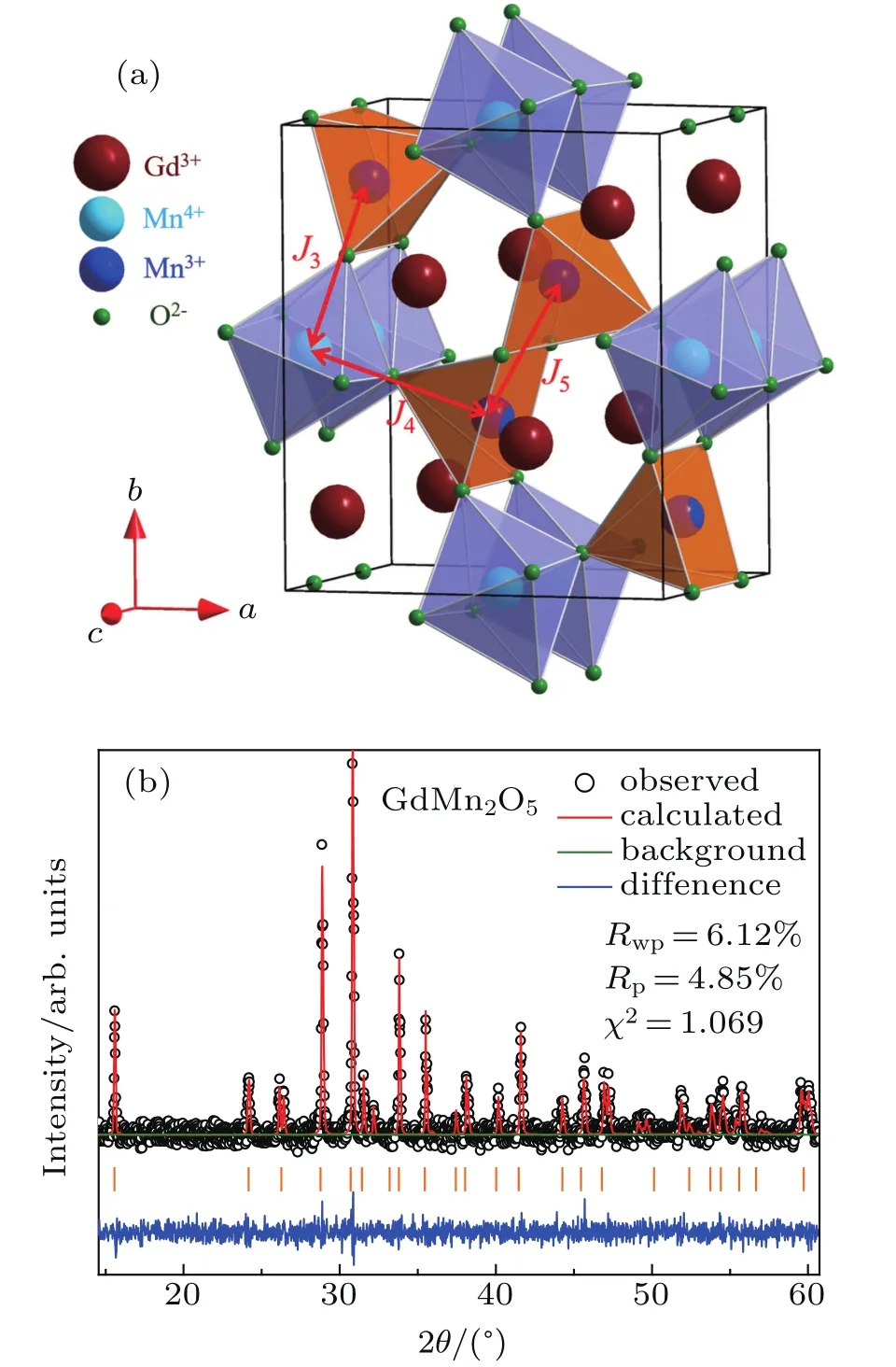
Fig.1.(a)Schematic drawing of the lattice structure of GdMn2O5 with three major Mn-Mn exchanges J3,J4,and J5;(b)measured θ-2θ XRD spectrum of polycrystalline sample and Rietveld method re fined data for comparison.
For more data about the specific heat,lattice distortion,and magnetism,one may refer to earlier work on R Mn2O5,[19,24,26,52]as well as our characterization in Fig.S3 of Supplementary Material.Here these results are brie fly summarized as follows.First,three anomalies are observed respectively at temperatures TN1∼41.0 K,TN2∼33.0 K,and TGd∼3.5 K,which indicate the multiferroic/magnetic phase transitions.Second,around TGd,a weak but clear peak appears,manifesting a ferroelectric transition associated with the independent Gd3+spin-ordering,which is different from the reported behavior for single crystal sample.[30]All of these are the typical features of type-II multiferroics.Moreover,we check the reliability ofthe pyroelectric method in ourmeasurements as shown in Fig.S4.The under-curve area of measured I(T)is roughly proportional to the heating rate,revealing that the measured current signals have no contribution from the detrapped charges during the sample heating,i.e.,the charges come entirely from the pyroelectric effect.
3.2.Low- TTT ferroelectricity associated with high- TTT polarized states
According to the above results of the low-T multiferroic properties,one can now measure the variations of these properties in response to different high-T polarized states.We first perform extensive measurements and then re fine several representative sequences for the present study as schematically shown in Fig.2.Here,the arrow indicates the poling path.Starting from Tst=300 K,a direct current(DC)electric field Ep1is applied to the sample during gradually cooling down to a “switching temperature”,Tsw,and then the field is switched to another value Ep2until Tend.It is noted that Ep1and Ep2can be positive or negative.For convenience,each case shown in Fig.2 is abbreviated as E ab(a,b=+,-,0).For example,E+-indicates Ep2>0 and Ep1<0 while E+0 refers to Ep2>0 and Ep1=0.We only consider the data measured under the poling field Ep=±10 kV/cm and 0.In our following experiments,we set vt=2 K/min,Tsw=45 K(slightly higher than TN1),and Tend=2 K,unless otherwise stated.
We present in Fig.3 the measured I(T)curves and evaluated P(T)curves undereightdifferentpoling sequences(E0±,E±0,E+-,E-+,E++,and E--modes),respectively.It comes immediately to us that the low-T ferroelectricity is tightly correlated with the high-T polarized state.For nonzero Ep1and zero Ep2(E0±),one can still detect remarkable signals I(T)and P(T).Surprisingly,the positive Ep1induces a sharp I(T)valley around TN2and a negative P below TN2,while the negative Ep1generates a positive P below TN2as shown in Figs.3(a)and 3(b).For zero Ep1and nonzero Ep2(E±0)shown in Figs.3(c)and 3(d),we observe the pyroelectric current I(T)that has been discussed in Fig.S3(c)before.The currentisalwayspositive ornegative in the whole T-range below TN2,depending on the nonzero poling field Ep2that appears in the temperature range from Tswto Tend.Moreover,the I(T)curve for Ep1<0 and Ep2>0(E+-case)exhibits a much higher peak around TN2,and the current peak shifts slightly toward the high-T side.Again,these data are surprising since a negative Ep1applied to the sample here does in fluence the polarization,while it is believed to be paraelectric when T>Tsw>TN2.This is certainly in discrepancy with conventional ferroelectric scenario.The data in the E-+case reveal the same feature.On the other hand,looking at the I(T)curve for Ep1>0 and Ep2>0(E++case),it is even more surprising that the current peak around TN2becomes negative and then switches to a positive value around 30 K.The data in the E--case also reveal the same feature.For all these cases,the current profiles around TGdremain roughly similar except for a weak anomaly at TGd.

Fig.2.(a)-(h)Electric poling sequences designed for the present experiments:modes E0+,E0-,E+0,E-0,E+-,E-+,E++,and E--,respectively.Here, field E p1 is applied in the temperature range from T st=300 K to T sw=45 K,and field E p2 is applied from T sw=45 K to T end=2 K.The corresponding device is schematically drawn below.
It is clearly demonstrated from the evaluated P(T)data in Fig.3 that the high-T polarized state plays a major role in the low-T ferroelectricity.First,the curves at E+-and E-+are symmetric with respect to each other,so are the curves at E+0 and E-0,the curves at E0+and E0-,and the curves at E++and E--.Second,the sign of polarization at the emerging point TN2seems to be determined by the sign of the poling field Ep1,suggesting that more than one polarization component exists in GdMn2O5,and at least one of them is correlated to Ep1.Third,we look at the signs of polarizations around TN2and TGd,P(TN2)and P(TGd),respectively,and the dependence of the sign on Ep1and Ep2is summarized in Table 1.In short,the sign of P(TN2)is opposite to that of Ep1and the sign of P(TGd)is the same as that of Ep2.
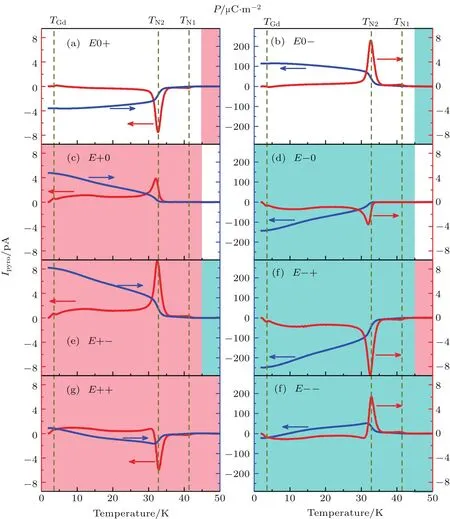
Fig.3.((a)-(h))Measured I(T)curves(red)and evaluated P(T)curves(blue)in eightpoling modes E0+,E0-,E+0,E-0,E+-,E++,and E--,respectively.Characteristic temperatures T N1,T N2,and T Gd are marked.Colored blocks represent applied poling fields in corresponding regions during sample cooling,with pink denoting E p,cyan denoting-E p,and white denoting 0.
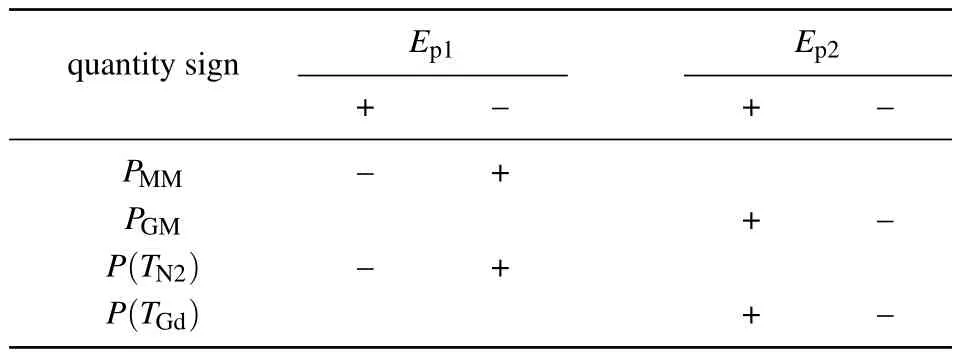
Table 1.Signs of several polarizations and their dependence on sign of E p1 and E p2.
3.3.Two polarization components
As stated above,obviously,there should exist more than one polarization component in the low-T range(T<Tsw),and here we only consider two components for simplicity.One component is PMMthat emerges around TN2.This component seems to be controlled by poling field Ep1,and the sign of PMMis opposite to that of Ep1.The other component is PGMthat also emerges around TN2,but the emerging point is slightly lower than that for PMM.This component seems to be controlled by poling field Ep2,and its sign is the same as that of Ep2.The total polarization Ptotwould be the sum of the two components,i.e.,Ptot=PMM+PGM.
To further confirm the existence of component PMM,we look again at the I(T)data for two specific poling sequences:E0-and E0+,while the data at E00 are probed as a reference.The data are plotted in Fig.4(a).While no remarkable signal is detected for the case of E00,positive I(T)and negative I(T)with corresponding peaks around TN2are recorded respectively.Moreover,to confirm the existence of component PGM,we also plot the I(T)data for two other specific sequences:E+0 and E-0 in Fig.4(a).Clearly,the positive and negative I(T)with corresponding peaks around TN2are probed,confirming that the component PGMis essentially aligned by the poling field Ep2.

Fig.4.(a)Measured I(T)curves in E0-,E0+,E+0,E-0,and E00 modes,and(b)Evaluated P(T)curves in E0-,E+0,E+-modes with the calculated polarization P calc=P(E0-)+P(E+0),showing that P calc is well consistent with total polarization in E+-mode.
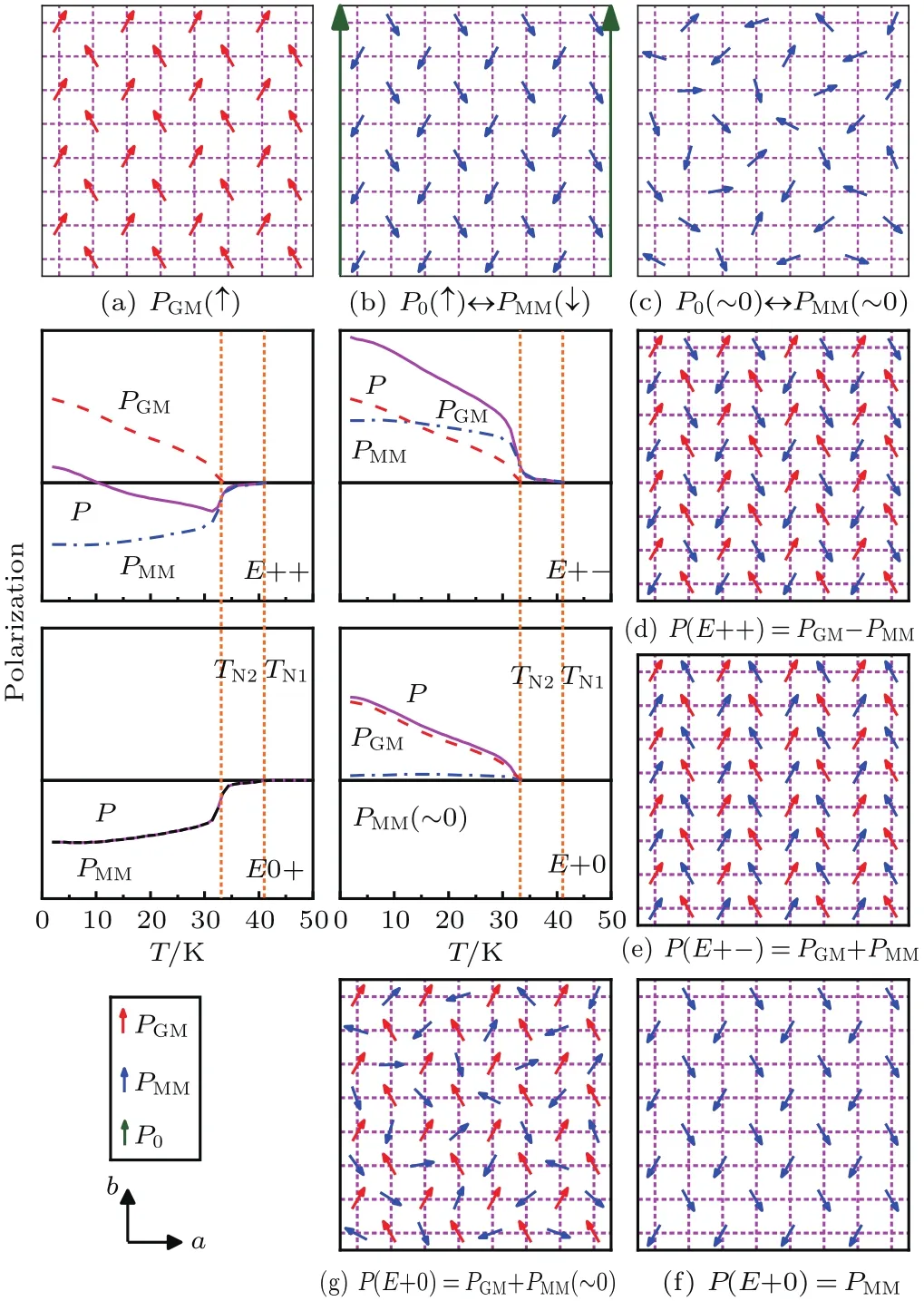
Fig.5.Proposed microscopic mechanisms forpolarization components P MM and P GM and their responses to four chosen electric poling modes:E++,E+-,E0+,and E+0 respectively.Total polarization P tot=P MM+P GM.Here P0 is assumed to be polarization of the high-T polarized state.Two components P MM and P GM constitute respectively a sublattice as shown in panels(a)and(b).P MM is clamped by high-T polarized state in the antiparallel form(P MM ↑↓ “P0”)but P GM is aligned by E p2 applied below T sw.P MM ∼0 if“P0”∼ 0,i.e.,E p1=0 as shown in panel(c).The low-T polarization lattices for the four modes are plotted in panels(d),(e),(f),and(g),respectively.
For this stage,a crude and probably over-simplified assumption can be made:it is noted that the two components PMMand PGMare mainly aligned by poling fields Ep1and Ep2respectively,while at the same time they are most likely irrelevant with the other one(poling field).It is interesting to note that the obtained Ptot(T)curve by summing PMM(T)curve under poling E0-and PGM(T)curve under poling E+0 is well consistent with the measured P(T)curve under poling E+-as shown in Fig.4(b).This consistency further confirms the above assumption,which allows us to discuss all the measured P(T)data under various poling sequences based on this assumption.For convenience of illustration,we present in Fig.5 the measured P(T)curves under the poling sequences E++,E+-,E0+,E+0.It is seen that all the curves can be well described by the different combinations of the two components,indicating that the low-T ferroelectricity below TN1for GdMn2O5is indeed a property of two-component physics.
Certainly,the two polarization components are magnetism-related.As suggested earlier,component PMMcan be assigned to the Mn-Mn symmetric exchange striction induced polarization and component PGMto the Gd-Mn symmetric exchange striction induced component.For GdMn2O5,it seems that the two components are not coupled with each other as in the case of DyMn2O5.This is understandable since the Gd spins were reported to be somehow isotropic and not tightly clamped by the neighboring Mn spins.[30,48]Although the ground state favors the parallel/antiparallel alignment of Gd spins with the neighboring Mn spins,the electric poling by Ep2below Tswmay induce the Gd spins to flip from one direction to its opposite direction due to the flip of PGM.
3.4.Clamping of PP MMMMMM by high- TTT polarized state
The core phenomenon observed in the present experiments is that component PMMis always opposite to poling field Ep1that is applied in the high-T range but terminated at a temperature Tswslightly higher than TN1.This is also one of the core issues for understanding the low-T multiferroicity of GdMn2O5,oreven the othermembers in the same family.This puzzling phenomenon raises serious concerns about the high-T polarized state that may determine the orientation of PMM.Since PMMis magnetism-generated and it will not appear until TN2<TN1<Tsw,the high-T magnetic fluctuations above TN1,if any,may in fluence the magnitude of PMMby reconfiguring the Mn spin ordering but have no way to determine the direction of PMM.The only possibility here is that there exists a high-T polarized state with a “virtual polarization P0”,if this state is electrically aligned by poling field Ep1.This“P0”is well saturated in the low-T range and thus contributes no pyroelectric current in the whole T-range below Tsw.
Given this well-aligned high-T polarized state with “P0”parallel to Ep1,the observed puzzling effect may be explained qualitatively. This polarized state is aligned by Ep1from Tst=300 K until Tsw=45 K that is sufficiently low for freezing this state.In this case,no matter whether a positive or negative Ep1enters below Tsw,this polarized state remains well frozen without much change until Tend.Our measured results suggest that this well-aligned polarized state does clamp the subsequently-appearing magnetism-induced polarization PMMat TN2,i.e.PMMis always antiparallel to “P0”,or Ep1.
The antiparallel clamping of PMMby “P0”is only a crude hypothesis without sufficient evidence so far.It is just proposed here to explain the observed results.Even so,one still has several reasons to favor this hypothesis.First,based on this hypothesis,the measured results about the low-T ferroelectricity can be reasonably understood.Second,earlier firstprinciples calculations on HoMn2O5did reveal the existence of two polarization components:ionic polarization and electronic polarization,and they are antiparallel to each other.[53]Neither of the two polarizations related to the Mn ions’contributions,corresponds to the “P0”or PMMhere,but it is inferred that the two polarizations are usually antiparallel if they coexist simultaneously in a system in order to lower the electrostatic energy.Third,one may discuss a specific case for the poling sequence E+0 or E-0.If no such clamping effect between PMMand “P0”exists,poling field Ep2applied in a temperature range from Tsw>TN2to Tendwould align both PMMand PGMin the same direction,leading to a large Ptot.However,our measured polarization is only PGMas shown in Fig.3.This suggests“P0”=0 if Ep1=0 and thus PMM∼ 0,i.e.,the local PMMis always clamped by the local“P0”.
3.5.Discussion
All of our discussion on the measured results of GdMn2O5reveals two major facts.On the one hand,it is revealed that the possible high-T polarized state has a strong in fluence on the low-T multiferroic behavior,in particular,the low-T ferroelectric polarization.Certainly,the Mn spin configuration would be dependent on the high-T polarized state although this prediction needs direct evidence from magnetic structure probing.This in fluence allows the low-T multiferroicity to be tuned by the high-T electric poling,which represents an electric control of multiferroicity or magnetism in the specific sense.On the other hand,it is claimed that the high-T polarized state can clamp the magnetism-induced polarization PMMbelow TN2,making the low-T multiferroicity fascinating.These two facts allow us to map the electric control of the low-T ferroelectricity for the four typical different poling sequences,referring to the proposed mechanisms for generating the two polarization components via the Mn-Mn and Gd-Mn symmetric exchange strictions.[33]The corresponding spin structures at low T are schematically drawn for illustration in Fig.5,using the main results revealed in the present work.
Nevertheless,the deficiencies or issues,requiring future investigation are also obvious.First,insufficient evidence for the high-T polarized state,or more specifically,no nature of this polarized state is given in the present work.It is a big challenge to probe the polarized state in the high-T range due to the very leaky problem,and more,whether this state is true is still a question.This problem is essential due to the narrow bandgap of R Mn2O5.Second,it is observed that polarization components PMMand PGMare non-coupled or only loosely coupled.The underlying physics remains to be revealed by carefully determining the Gd and Mn spin structures in the low-T range,such as by using neutron scattering.Third,we come back to the issue of sample quality.The careful and reliable measurements on single crystals rather than polycrystalline samples would be highly preferred for additionally validating the conclusion of this work,although an effective approach to excluding the strong self-polarized effect on the single crystal surfaces would be a big challenge.
4.Conclusions
In the present work,focusing on the correlation of the probable high-T polarized state with the magnetically induced electric polarization in the low-T range,we perform extended measurements of GdMn2O5in its polycrystalline form.It is revealed that the high-T electric poling routine plays a vital role in controlling the low-T multiferroic behavior.The results suggest that there are two main magnetism-related polarization components responsible for the observed unique scenarios,which refer to component PMMgenerated by the Mn-Mn exchange striction and component PGMgenerated by the Gd-Mn exchange striction.The component PMMis obviously tightly clamped by the high-T polarized state while the component PGMis not.The present work provides a comprehensive understanding of the relationship between low-T multiferroicity and high-T polarized state in GdMn2O5,and also presents a representative case where how multiferroicity can be controlled by electrical poling.
猜你喜欢
杂志排行
Chinese Physics B的其它文章
- Physics of quantum coherence in spin systems∗
- Recent progress of infrared photodetectors based on lead chalcogenide colloidal quantum dots∗
- Progress in quantum well and quantum cascade infrared photodetectors in SITP∗
- Recent advances in Ga-based solar-blind photodetectors∗
- Development of long-wavelength infrared detector and its space-based application requirements∗
- Transition of photoconductive and photovoltaic operation modes in amorphous Ga2O3-based solar-blind detectors tuned by oxygen vacancies∗
